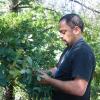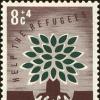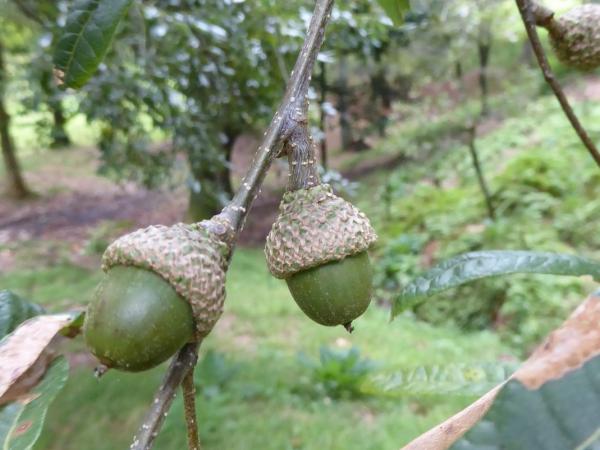Editor's Picks
Plant Focus
Hybrid Highlight: Quercus ×hispanica Lam. - A Non-Hispanic Hybrid
[N.B.: This article was published before the name of the hybrid was changed from Quercus ×hispanica to Q. ×crenata.]
A naturally occurring hybrid, widely adopted by the nursery trade in the form of cultivars, labors under a misnomer: there is precious little Hispanic about Quercus ×hispanica. Its parents are Q. suber (cork oak), whose range stretches from Western to Central Mediterranean, and Q. cerris (Turkey oak), which is found in South Central Europe and Turkey. The intersection of these ranges is southeastern France and Italy. The only naturally occurring specimens in Spain would date from after the introduction of Q. cerris to Spain, which happened around 1780.

of Quercus cerris (above)
and Q. suber (below).
Source: Wikipedia
In 1783[1], when Jean-Baptiste Lamarck penned the volumes on Botany in the Encyclopédie méthodique, there were three specimens of this hybrid (he considered it to be a species) growing in the Royal Garden at Trianon in Paris, France. He named them “Chêne d’Espagne” (oak of Spain), as one of them was commonly known as “Chêne de Gibraltar”. At the end of his description of the tree, Lamarck writes: “Ce beau Chêne croît, à ce qu’on prétend, aux environs de Gibraltar.” (This beautiful oak grows, it is claimed, in the neighborhood of Gibraltar.) So it was on the basis of hearsay that Lamarck chose the epithet hispanica. Despite the untruth, it stuck.
The features of each parent are present to varying degrees in the hybrid: the bark runs the gamut from corrugated to corky; the leaves are evergreen or semievergreen, sometimes falling in harsh winters, but often persisting till new growth in spring; the cupules are covered with bristles like Q. cerris, but the revolute scales may vary in length. In France this tree receives its own common name (drouis) and in Italy it is distinguished in the same way, though the name is a combination of the names of the parents (cerrosughera) or a diminutive of the name for cork oak (sugherella). There is debate as to whether Q. crenata (another name coined by Lamarck in the same publication that included Q. hispanica) is in fact a species or instead a stabilized hybrid of Q. cerris and Q. suber, and hence a synonym of Q. ×hispanica.

The broad diversity of phenotypes offered by this hybrid make it attractive for the nursery trade, particularly as it makes desirable attributes of Q. suber (corky bark and evergreen habit) available in hardier forms that can be planted in climates where cork oak would not prosper. One of the earliest selections was made by William Lucombe around 1763 in his nursery in Exeter, UK, when he noticed that a seedling Q. cerris (introduced to the UK in 1735) kept its leaves in winter. The tree was later propagated by grafting onto Q. cerris stock and widely distributed, to such an extent that Lucombe oak became a common name for any hybrid of the same parentage (and was even published as Q. ×lucombeana).[2] W.J. Bean describes it as “a handsome and stately tree of a distinct habit when mature, with spreading branches upswept at the ends and swollen at the base.” A fine specimen grows in Kew Gardens, originally planted in 1773 and later moved (as a 73-year-old tree) 20 meters north to make way for a vista, in what must have been a major operation in those days. True Lucombe oaks are clones of the original tree, but as they produce fertile acorns, many seedlings exist which are back crosses with Q. cerris, particularly in Devon, Lucombe’s stomping ground.

Right: Herbarium specimen of Quercus hispanica var. α, the "oak of Gibraltar", in Lamarck's herbarium
(Source:http://www.lamarck.cnrs.fr/)
Another cultivar, ‘Crispa’, was grown by William Lucombe’s son and was a seedling of the original Lucombe oak. It is known as “New Lucombe oak” and has smaller leaves and a more compact habit. William Lucombe Sr. was quite enamored with the original tree that would perpetuate his name: in 1785 he had it felled and cut into boards to be stored under his bed till they could be used to make his coffin (the sort of foresight one might describe as “thinking inside the box”). He actually lived to be 102, by which stage the treasured wood had decayed, so another Lucombe oak was felled for the funereal furnishings.

Another well-known cultivar of Q. ×hispanica was selected more recently, in 1909, at the arboretum of Count Ambrózy-Migazzi in Mlyňany, present day Slovakia. This form also owed its selection to the persistence of its leaves in winter. The story goes that one day in February, some woodcutters were seen in a tavern sportingsprigs of green oak in their hats. This alerted Josef Mišák, manager of Arboretum Mlyňany, that an evergreen oak grew nearby. Count Ambrózy-Migazzi was particularly interested in evergreen species (the motto of his Arboretum was Semper vireo, “I am always green”) and soon Mišák located the evergreen oak in a nearby plantation of chestnuts. This cultivar shows an affinity towards Q. cerris and at a time was considered to be a variety of that species, but it is now accepted to be a hybrid with Q. suber. Ambrózy propagated it profusely and it is thought that as many as 200 of them once grew in his park, but they were all eventually lost. Today, the Arboretum has only one specimen of Q. ×hispanica ‘Ambrozyana’, reintroduced from Hillier Gardens and Arboretum in the UK.

Whereas most specimens show characteristics that are intermediate between those of the parents, some take on a life of their own. Such is the case of ‘Diversifolia’, which as the name suggests behaves like an unruly child as far as leaf shape is concerned. Usually the middle section of the blade is reduced to a narrow strip, only a few millimeters across, and may widen at the base or tip, or not, in forms that have been described as fiddle- or spoon-shaped. The margins are entire or have three to five lobes. It is of uncertain origin and was distributed as early as 1877. It is fully evergreen, has an erect habit and corky bark, and grows rapidly, being one of the more rustic selections of the hybrid.

Other notable cultivars include ‘Fulhamensis’, the Fulham oak, selected at the nursery of Whitley and Osborne in Fulham, London around 1760 (according to Bean, this was one of the three “Spanish” oaks growing at Trianon that were described by Lamarck); ‘ Wageningen’, a Naktuinbouw selection found at Wageningen in the Netherlands in 1979, which may be a hybrid with another species (Q. castaneifolia and Q. trojana have been suggested); and ‘Waasland Select’, a cultivar with unusual leaf shape, similar to ‘Diversifolia’, propagated from a tree at Arboretum Hof ter Saksen in Belgium (according to the late Michael Heathcoat Amory, it could be a form of Q. ilex).
Whether as a hybrid occurring naturally where both its parents grow, or further afield where human endeavor has stretched that range, Q. ×hispanica merits attention. It is a good example of the potential benefits of hybridization, taking attractive characteristics to regions where they would otherwise not survive, or creating new ones that are not manifest in the parental phenotypes.

With thanks to Nick Macer for bringing to my attention Alan Mithchell's text about the Lucombe oak, to Allen Coombes for doing the same regarding Francisco Vázquez et al.'s article in Lazaroa, and to Michel Timacheff for permission to use his photos.
Further reading:
Books
Amory, M.H. The Oaks of Chevithorne Barton. London: Adelphi, 2009. (pp. 96-97)
Beaulieu, A Le Hardÿ de, T. Lamant, M. Timacheff, E, Jablonski, and P. De Spoelberch. Guide Illustré des Chênes. Paris: Ed. du 8ème, 2006. (Tome 1, pp. 362-379)
Mitchell, A. Alan Mitchell's Trees of Britain. London: HarperCollins, 1996. (pp.300-304)
Web
Bean’s Trees and Shrubs: http://www.beanstreesandshrubs.org/browse/quercus/quercus-x-hispanica-lam/
Arborétum Mlyňany website: http://www.arboretum.sav.sk/sk/o-arborete/general-information/history/
Rivista Forestale Sherwood – Profilo. Come riconoscere le querce sporadiche: farnia, rovere, sughera e cerro sughera (video, in Italian) https://www.youtube.com/watch?v=7ABBVXgYkHM
[1] The first volume of Encyclopédie Méthodique (Botany) was published in two parts, in December 1783 and August 1785. Quercus hispanica is described on page 723 in the second part, hence the date in the accepted name of the taxon: Q. xhispanica Lam. (1785)
[2] Alan Mitchell in his book The Trees of Britian (1989) calls for the name Q. ×hispanica to be rejected as “completely illegitimate” and replaced with Q. ×lucombeana Sweet, because the name published by Lamarck was applied to three trees in the Trianon, one of which was, according to Elwes and Henry, Q. ×turneri (Q. robur × ilex). This motion has not prospered, and Q. ×hispanica is currently accepted by Kew’s World Checklist of Selected Plant Families and other sources. More recently, in 2014 Carlos Vila-Viçosa, Francisco M. Vázquez, Catarina Meireles, and Carlos Pinto-Gomes proposed a new name for Lamarck's “Chêne de Gibraltar”: Quercus gaditana. (See full article here.)











